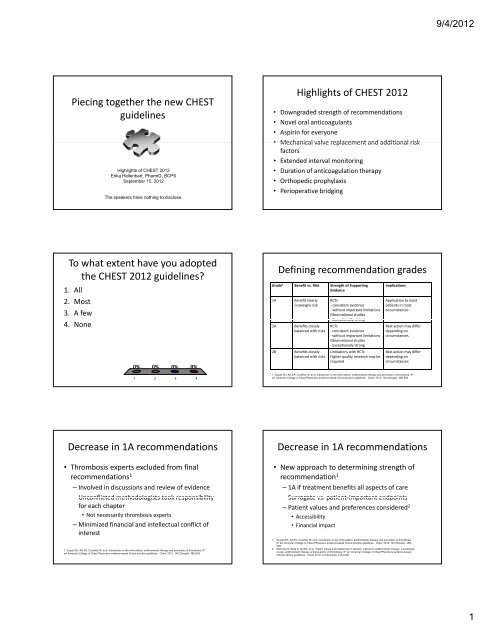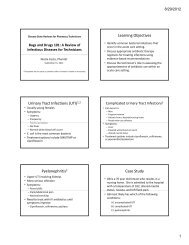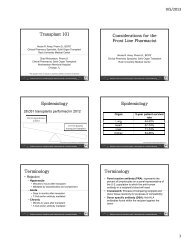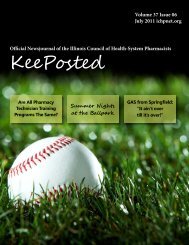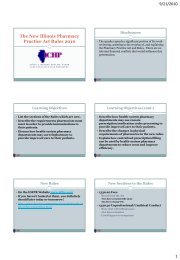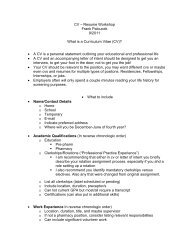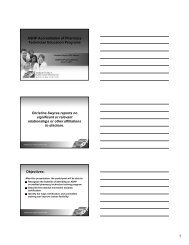Presentation Outline ICHP Annual Meeting September 13-15
Presentation Outline ICHP Annual Meeting September 13-15
Presentation Outline ICHP Annual Meeting September 13-15
Create successful ePaper yourself
Turn your PDF publications into a flip-book with our unique Google optimized e-Paper software.
Piecing together the new CHEST<br />
guidelines<br />
Highlights of CHEST 2012<br />
Erika Hellenbart, PharmD, BCPS<br />
<strong>September</strong> <strong>15</strong>, 2012<br />
The speakers have nothing to disclose.<br />
To what extent have you adopted<br />
the CHEST 2012 guidelines?<br />
1. All<br />
2. Most<br />
3. A few<br />
4. None<br />
0% 0% 0% 0%<br />
1 2 3 4<br />
Decrease in 1A recommendations<br />
• Thrombosis experts excluded from final<br />
recommendations1 – Involved in discussions and review of evidence<br />
– Unconflicted methodologists took responsibility<br />
for each chapter<br />
• Not necessarily thrombosis experts<br />
– Minimized financial and intellectual conflict of<br />
interest<br />
1. Guyatt GH, Akl EA, Crowther M, et al. Introduction to the ninth edition: antithrombotic therapy and prevention of thrombosis, 9 th<br />
ed: American College of Chest Physicians evidence-based clinical practice guidelines. Chest. 2012; 141(2)(suppl): 48S-52S.<br />
Highlights of CHEST 2012<br />
• Downgraded strength of recommendations<br />
• Novel oral anticoagulants<br />
• Aspirin for everyone<br />
• Mechanical valve replacement and additional risk<br />
factors<br />
• Extended interval monitoring<br />
• Duration of anticoagulation therapy<br />
• Orthopedic prophylaxis<br />
• Perioperative bridging<br />
Defining recommendation grades<br />
Grade 1 Benefit vs. Risk Strength of Supporting<br />
Evidence<br />
1A Benefit clearly<br />
outweighs risk<br />
2A Benefits closely<br />
balanced with risks<br />
2B Benefits closely<br />
balanced with risks<br />
RCTs<br />
‐ consistent evidence<br />
‐ without important limitations<br />
Observational studies<br />
‐ Exceptionally strong<br />
RCTs<br />
‐ consistent evidence<br />
‐ without important limitations<br />
Observational studies<br />
‐ Exceptionally strong<br />
Limitations with RCTs<br />
Higher quality research may be<br />
required<br />
Implications<br />
Application to most<br />
patients in most<br />
circumstances<br />
Best action may differ<br />
depending on<br />
circumstances<br />
Best action may differ<br />
depending on<br />
circumstances<br />
1. Guyatt GH, Akl EA, Crowther M, et al. Introduction to the ninth edition: antithrombotic therapy and prevention of thrombosis, 9 th<br />
ed: American College of Chest Physicians evidence-based clinical practice guidelines. Chest. 2012; 141(2)(suppl): 48S-52S.<br />
Decrease in 1A recommendations<br />
• New approach to determining strength of<br />
recommendation1 – 1A if treatment benefits all aspects of care<br />
– Surrogate vs. vs patient patient‐important important endpoints<br />
– Patient values and preferences considered2 • Accessibility<br />
• Financial impact<br />
1. Guyatt GH, Akl EA, Crowther M, et al. Introduction to the ninth edition: antithrombotic therapy and prevention of thrombosis,<br />
9 th ed: American College of Chest Physicians evidence-based clinical practice guidelines. Chest. 2012; 141(2)(suppl): 48S-<br />
52S.<br />
2. MacLean S, Mulla S, Akl EA, et al. Patient values and preferences in decision making for antithrombotic therapy: a systematic<br />
review: antithrombotic therapy and prevention of thrombosis, 9 th ed: American College of Chest Physicians evidence-based<br />
clinical practice guidelines. Chest. 2012; 141(2)(suppl): e1S-e23S.<br />
9/4/2012<br />
1


